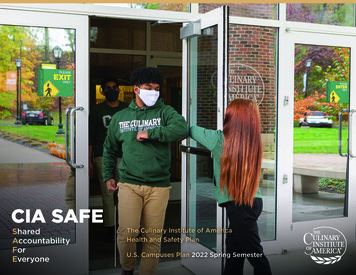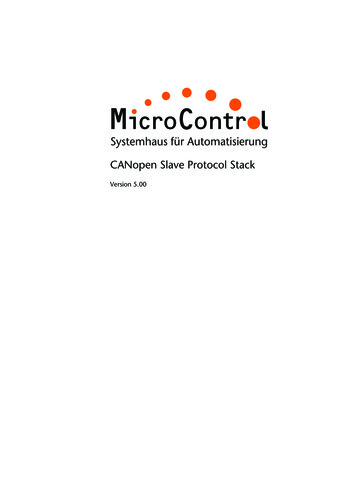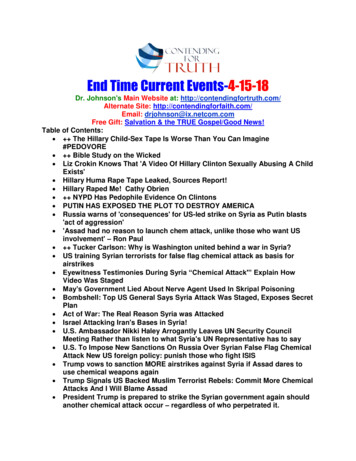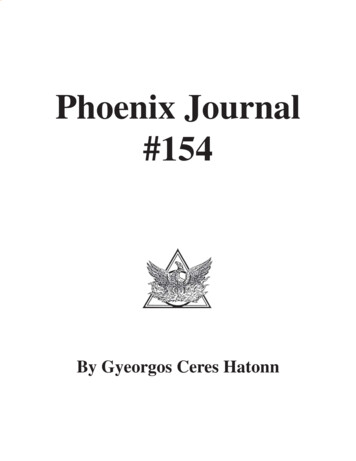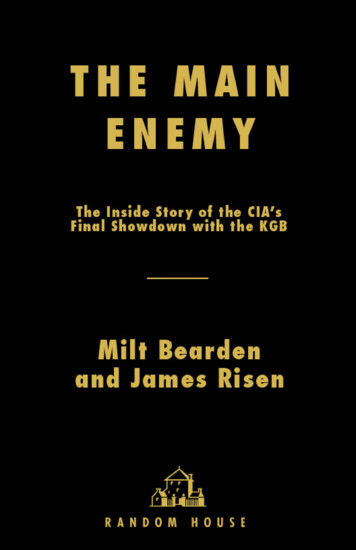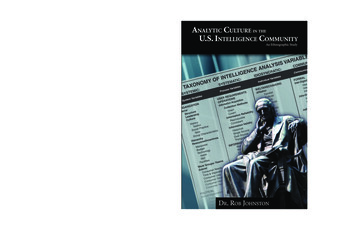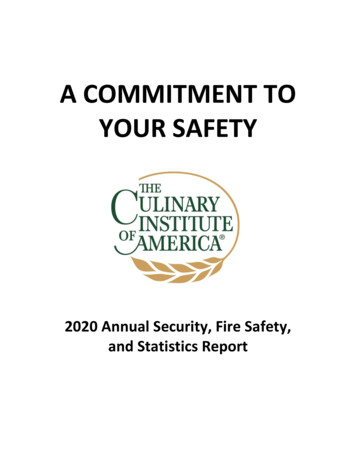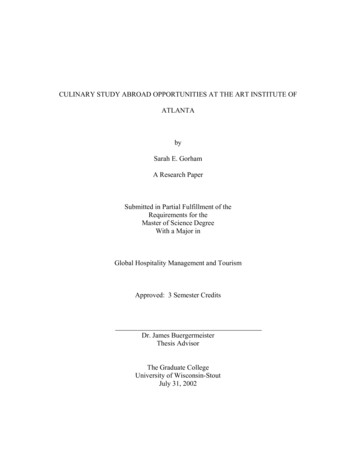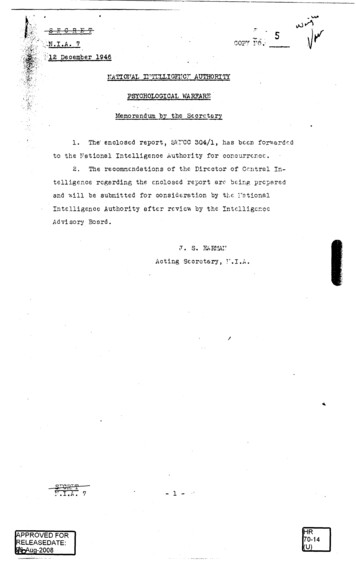
Transcription
STC1FTcop7 r6.7512 December 1946TIOA IrTrulorrerAUTHORITYPSYCHOLOGICAL WARFAREMemorandum by the SecretThe' enclosed report . , 81i TCC 304/1, has been forltarded1.to the Yational Intelligence Authority for corlcurrence.The recommendations of the Director of Central In-2.telligence regarding the enclosed report are being preparedand uill be submitted for consideration by the.Intelligence Authority after revieu by the IntelligenceAdvisory ,Board.J. S. EART1ArActing Secretary,7APPROVED FORRELEASEDATE:gboaug-20081HR70-14(U)
COPY NO.91SWNCC 304/110 December 1946P:-es 3 - 28, incl.STATE-WAR-NAVY COORDINATING COMMITTEEPSYCHOLOGICAL WARFAREReference: SWNCC 304Note by the Secretaries1.The enclosure, a report by the ad hoc Committee inresponse to the above reference, is circulated for considerationby the Committee.2.Copies of this report have been forwarded to theSecretaries of the Joint Chiefs of Staff and the National Intelligence Authority for concurrence. The views of the JointChiefs of Staff and the National Intelligence Authority will becirculated to the Committee unon receipt thereof from theSecretaries of the Joint Chiefs of Staff and the NationalIntelligence Authority.H. W. MOSELEYW. A. SCHULGENV. L. LOWRANCESecretariatSWNCO 304/1
SECRETENCLOSUREPSYCHOLOGICAL WARFAREReport of the Ad Hoc CommitteeTHE PROBLEM1, To review World War II efforts in Psychological Warfare,to study and report on the future status of psychological warfare,and recommend:a. A peacetime organization for keeping psychologicalwarfare in a ready-for-mobilization status;b. A wartime psychological warfare organization;both organizations to be assigned such directives aswill insure effective planning, coordination and implementation, particularly with respect to the integration ofnational psychological warfare with military plans.FACTS BEARING ON THE PROBLEM AND DISCUSSION2. Psychological Warfare is defined as the planned use, during time of war or threat of war, of all measures, exclusive ofarmed conflict, designed to influence the thought, morale; orbehavior of a given foreign group in such a way as to support theaccomplishment of our military or national aims with the following objectives:a. To assist in overcoming an enemy's will to fight;b. TO sustain the morale of . friendly.groups in countriesoccupied by the enemy;c. To improve the morale Of friendly countries and theattitudes of neutral countries toward the United States.5. For further Facts Bearing on the Problem and Discussion,see Appendix "B":CONCLUSIONS4. It is concluded that:a, Psychological Warfare As an essential factor in theachievement of national aims and military objectives in timeof war, or threat of war as determined by the President.SWNCO 304/1-.3-3ECRETEnclosure
b. The State Department has primary interest in psychological warfare policy determination which affects theforeign policy of the United States.c. The armed services have a vital Interest in psychologicalwarfare policy . determination which affects the nationalsecurity and the conduct of military operations of the UnitedStates.d. The National Intelligence Authority has an interest inthe intelligence and certain other aspects of psychologicalwarfare,e. There is need for the immediate establishment of acommittee with full-time representation from appropriategovernmental agencies to serve as an agency charged withpreparation of psychological warfare policies, plans, andstudies for employment in time of war, or threat of war asdetermined by the President.f. Appropriate agencies of the government should be required to assist in wartime implementation of approvedpsychological warfare plans.E. The implementation of psychological warfare plans anddirectives during wartime in an actual or projected militarytheater of operations should be an active responsibility ofthe Theater Commander concerned.RECOMMENDATIONS5. It is recommended that . the SWNCC:a. Approve Appendix "A (a charter for the Agency proposed in paragraph 4 e), subject to the concurrence of theNational Intelligence Authority and the Joint Chiefs ofStaff.b. Thereafter, transmit this report to the Secretariesof State, War and Navy, the Joint Chiefs of Staff, and theDirector of Central Intelligence, for guidance andappropriate measures of implementation.SWNCC 304/1- 4 SECRETEnclosure
6 Ec. Obtain the 'comments or concurrence of the CentralIntelligence Group and the. Joint Chiefs of Staff, when andas appropriate, in connection with psychological warfareplans developed by the Subcommittee provided for in Appendix.itA ll before acting on them.SWNOC 304/1- 5 -Enclosure
APPENDIX ItAllDRAFT.CHARTERSWNC SUBCOMMITTEE ON PSYCHOLOGICAL WARFARE (P. w. C.)ORGANIZATION1. The Subcommittee on Psychological Warfare (P.W.C.) ishereby established as the agency of the State-War-Navy Coordinating Committee (SWNCC), charged with preparation of policies,plans, and studies for immediate and continuous employment ofnational psychological warfare in time of war (or threat of waras determined by the President). The Subcommittee shall haveauthority, in the absence of a national wartime organization forpsychological warfare, to coordinate implementation of approvedpsychological warfare plans in any war emergency which mightsuddenly arise.2. Psychological Warfare is defined as the planned use, during time of war or threat of war, of all measures, exclusive ofarmed conflict, designed to influence the thought, morale, orbehavior of a given foreign group in such a way as to support the accomplishment of our military or national Aims, with the following objectives:a. To assist in overcoming an enemy's will to fight;b. To sustain the morale of friendly groups in countriesoccupied by the enemy;0. To improve the morale of friendly countries and theattitudes of neutral countries toward the United States.MEMBERSHIP3. The Subcommittee on Psychological Warfare will consist ofa. Two officials of the State Department, one of whomwill serve as chairman.b. Two officials of the Central Intelligence Group.c. One officer- of the War Department.d. One officer of the Navy Department.SWNCO 304/1- 6 -Appendix "A"
t—ECRET4.The members of the P.W.C. will, insofar as practicable,be assigned no other duties.5. Alternate members shall be designated to act for membersin absentia.6. The P.W.C. will be provided by SWNCC with a permanentSecretariat.7.The Subcommittee on Psychological Warfare shall beresponsible for the:a. Preparation of national plans and implementing directives relating to the employment of psychological warfare intime of war (or threat of war as determined by the President), and for transmission of subject plans to SWNCC.b. Preparation of plans for orderly and effective organizational transition of the P.W.C. from peacetime to wartimestatus, and for transmission of these plans to SWNCC.c. Coordination of implementation of approved plans anddirective as ope3t.fle5. in a, preceding, in the absence ofa national wartime organization for psychological warfare.d. Guidanoe and supply of necessary information, including implementing requirements therefor, concerning nationalpsychological warfare plans to appropriate policy officesof the State, War and Navy Departments and to the Directorof Central Intelligence, and to authorized coordinatingagencies of other Departments of the Government of theUnited States.4.PROCEDURE' 8. The Subcommittee on Psychological Warfare shall:a. Establish its own method of procedure.b. Maintain close liaison with the appropriate policyoffices of the State, War, and Navy Departments, and withauthorized coordinating agencies of other Departments ofthe Government of the United States.SWNCC 304/1- 7-Appendix "A"
c. Utilize the services of the Central IntelligenceGroup (GIG) for necessary intelligence in the preparationof plans, studies, and reports.d. Under authority of this charter, request the presenceat committee Meetings, as consultants, of representativesfrom the policy and functional offices of the State, War, orNavy Departments, and the Central . Intelligence Group,e. If unable to reach agreement on policies, plans, ordirectives, report promptly to SWNOC.9. Plans and directives specified in paragraph 7 a above,which are to be implemented in actual or projected militaryareas, theaters or . commands, will, following their approval, betransmitted by rapid communication to the military commandersconcernea . by the JoAnt Chiefs of Staff, only. Responsibilityfor implentation Df suoll plane and direoiAves will be that ofthe commanders oonc ,Jrned, solely.SWNCC 304/1- 8Appendix "A"
SE 011.,ET'APPENDIX "B7.FACTS 3P,ARING ,Op THE ITOBLEM1. The United States organization for psychological warfarein World War I/ was affected, by the following developments:a. 11 July 1941. The Office of Coordinator of Information (COI) was established by Presidential Order to collect,analyze, and correlate information and data bearing onnational security, to make such data available to the President and such other officials as determined by the President,and to perform related aptivities. COI commenced operationson the premise that this agency would not only coordinateall incoming information, but also information flowing fromthe United States to the rest of the world. The ForeignInformation Service was organized as a separate branch ofCOI, was situated in New York City, and was charged withthe responsibility of coordinating international broadcasting from this country.b, 30 July 1941. The Office of the Coordinator of InterAmerican Affairs (CIAA) was created by Exeoutive Order.This office was an outgrowth of the Office for Coordinationof Commercial and Cultural Relations Between the AmericanRepublics, created by the Council of / National Defense on16 August 1940. CIAA was assigned broad functions as coordination center of commercial and cultural relations withother American republics, and was responsible for furtheringcommeroial and economic well-being in the Western Hemisphere.c. 30 July 1941, The Board of Economic Warfare (BEW)was established (originally as the Economic Defense Board)by Executive Order for the purpose of developing and coordinating policies, plans, and programs designed to protectand strengthen the international economic relations of theUnited . States in the interest of national defense. (Eventually BEW was'consolidated into the Foreign EconomicAdministration.)SWNCC 304/1 - 9 -Appendix "B"
. SECRETd. 26 October 1941. The Office of Facts and Figures (OFF)was created by Executive Order for the purpose of facilitating dissemination of factual information to the citizens ofthis country on the progress of defense efforts and on thedefense policy and activities of the government.e. 3 March 1942. The Joint Chiefs of Staff (JCS) created(in JCS 12) the Joint Psychological Warfare Committee (JFWC)which was envisaged as the ultimate authority over bothforeign propaganda and foreign secret (subversive) operations.(This committee's functions later were absorbed by otheragencies.)f, 13 June 1942. The Office of War Information (Owl) wasestablished by Executive Order of the President for the purpose of coordinating into one agency war information functions of the government---foreign and domestic. The Executive Order brought the Office of Facts and Figures (OFF)into the new agency, and abolished the Office of Coordinatorof Information (COI), exclusive of the Foreign InformationService which was transferred to OWI.E. 13 June 1942. The Office of Strategic Services (OSS)was established by Military Order under the jurisdiction ofthe Joint Chiefs of Staff for the purpose of collecting andanalyzing such strategic information 5s required by theJoint Chiefs of Staff for military operations in planningand in conducting special operations not assigned to othergovernment agencies.h. 22 February 1943. The Director of OSS sent to theJoint Chiefs of Staff a memorandum enclosing the first"overall strategic plan for United States psychologicalwarfare." This memorandum became JCS 230 dated I March1943. (Certain provisions of the memorandum having to dowith the functions of OSS were approved by the Joint Chiefsof Staff in JCS 155/11/D on 27 October 1943.)i. 2March 1943. The Joint Chiefs of Staff approved thefirst basic plan for psychological warfare prepared by OSS.(Basic Plan for Psychological Warfare in Italy, containedin JC8*139/2.)SWNC0 304/1- 10 SECRE.TAppendix "3"*
6hURET1.10 March 1943. The President issued the followingclarifying order with respect to the responsibilities ofOWI and OSS:The Office of War Information will plan, develop,and execute all phases of the federal program of radio,press, publication, and related foreign propagandaactivities involving the dissemination of information.The program for foreign propaganda in areas of actualor projected military operations will be coordinatedwith military plans through the planning agencies of theWar and Navy Departments, and shall be subject to theapproval of the Joint Chiefs of Staff. Parts of theforeign propaganda program which are to be executed ina theater of military operations will be subject to thecontrol of the theater commander. The authority, functions, and duties of the Office of War Information shallnot extend to the Western Hemisphere, exclusive of theUnited States and Canada."The military order of June 13, 1942, establishingthe Office of Strategic Services, is hereby modified tothe extent necessary to make this order effective."It.17 March 1943. The Joint Chiefs of Staff authorizedliaison. officers for the War and Navy Departments withduties as follows:To sit as members of the Overseas Planning Groupof OWI.To maintain contact with all planning agencies of theJCS and to furnish the Overseas Planning Group of theOffice of War Information with as much of JCS plans asauthorized by Joint Security Control (an agency of theJoint Chiefs of Staff), and as necessary to insurecorrelation between military and propaganda plans.To transmit requests from JCS to OWI relative topropaganda activities desired for the purpose of furthering military operations.To present to the JCS all propaganda plans which required their approval.MCC304/1Appendix "B"*
-1F-E-0-/t1t-T--1. 27 October 1943. In JCS 155/11/D, Joint SecurityControl Was charged with direction of the timing of thestrategic service measures initiated from the United Statesby the OSS.m. 4 December 1944. In JOS 1178/1, Joint Security Control was directed to bring to the attention of the JointChiefs of Staff liaison officers with OWT such JCS papersas were likely to be of interest to OWI,2. The foregoing directives, in their successive steps,formulated the government's policy with respect to informationand foreign propaganda, and established organizations designedto provide foi, coordinated planning and implementation of foreignpropaganda and foreign secret (subversive) operations. Withrespect to information, various governmental agencies operatedto inform the United States public of our progress in the war.These agencies were subject to voluntary censorship and to cableand postal censorship. With regard to foreign propaganda andforeign secret (subversive) operations, governmental organizations operated to overcome the enemy's will to fight and tosustain the morale of friendly groups in countries occupied bythe enemy. In addition, there was an attempt, divided betweeninformation and propaganda agencies, to improve the morale offriendly countries and the attitudes of neutral countries towardthe United States.3. Foreign propaganda and foreign secret (subversive) operations were directed so as to discredit the enemy's government andleaders, to stimulate divisions between dissident enemy peroone *and groups, to persuade the enemy military and enemy civilianpopulation of the hopelessness of their situation, and to meetthe enemy propaganda with counter-propaganda. These tasks wereaccomplished by "white" propaganda and "black" measures, Ingeneral, "white" propaganda was overt---issued from reputable,known U.S, official or other sources, or from countries known tobe friendly to the United States, and implemented by radio,SWNCC 304/1- 12 -Appendix "B"
1CREleaflets, pamphlets, and sonic means. "Black" measures werecovert---apparently conducted by forces friendly to the enemy orby subversive forces within enemy territory, and implemented byradio "freedom" stations, false rumors, false leaflets or documents, fifth column activities, sabotage, guerilla warfare, andsupport of underground resistance groups. 4. Directives outlined in paragraph 1 above eventually resulted in the following procedure (also shown on chart, Annex"A") within the organizations dealing with phases of psychological warfare:a. "White". The Director of the Office of War Information (Owl), in planning and executing the federal programof overseas propaganda, had an Overseas Planning Board, onwhich were represented OWI, the State Department, andliaison officers of the Joint Chiefs of Staff. CIAA and theBritish Political Warfare Commission were represented byobservers, for purposes of information and coordination.This board, following the general structure of an overallplan approved by the Joint Chiefs of Staff, prepared aweekly Central Directive for overseas propaganda which wascleared through agencies of the State Department and theJoint Chiefs of Staff. These directives (and other supporting ones) were transmitted to OWI offices and to majorpsychological warfare agencies in military commands abroadas the established U.S. government propaganda policy. InLondon, a combined directive was worked out by U.S. and .British foreign propaganda agencies to govern all combinedEuropean Theater propaganda operations.b. "Black". The Director of the Office of StrategicServices (OSS) had a Planning Group, on which were represented OSS, the State Department, and the War and NavyDepartments. An Advisory Committee served . with the OSSPlanning Group to consider matters affecting the respectiveagencies represented on the committee. Representatives onSWNCC 304/1- 13 -Appendix "B"
the Advisory Committee were from the Office of Economic Warfare, Coordinator of Inter-American Affairs, TreasuryDepartment or other appropriate agencies. The PlanningGroup, 'following the general directives flowing from anoverall plan approved by the Joint Chiefs of Staff, preparedfrequent directive6 for overseas operations, the timing ofwhich was under the direction ofa.Joint Chiefs of Staffagency, Joint Security Control. These directives werecommunicated to OS agencies overseas as the establishedU.S. policy for secret operations.0. Coordination between OSS and OWI was on a basis ofinformal cooperation. Approval of 053, and OWI plans formilitary theaters of operationprojected operations wasvested in the Joint Chiefs of Staff, In military theaters,coordination was conducted through the normal militarycommand, channels,d, The Army and Navy conducted psychological warfareoperations, partially through OSS and OWI agencies, andpartially,through their own organizations. Agencies forpsychological warfare operations were developed in alltheaters of operations, usually on the basis of a specialstaff section of the theater commander's staff, which maintained close liaison with the intelligence section. Inaddition, field operating teams for front-line combatpsychological warfare were employed by the armed services.OWI and OBS personnel in military theaters were nominallyintegrated into the military organization, which assumedresponsibility for their logistical support.e. The CIAA operated semi-independently, with"information" measures designed to improve economic andcommercial . interests between the United States and thecountries of Central and South America.5. The following problems with respect to psychologicalwarfare existed at the end of World War II:SWNCC 304/1- 14-Appendix 1113"
bh(ittLia. Coordination of OSS %lack" and OWI "white" plansand operations at the Washington level remained on a basisof informal cooperation, which did not always result incoordination.b. The national psychological organization was such thatthere was duplication of effort, competition for availablesupplies of personnel, slow , and limited coordination andintegration into the major military, political and economicprograms of the government.c. Directives overseas were subject to delays in transmission which often negated their use,d. Military theater commanders received psychologicalwarfare directives from OSS or OWI.DISCUSSION6.Examination has been conducted by the ad hoc Committeeof World War II C.C.S, J,C.S., and J.1'. S. papers; executive andother orders of the President; reports from military commandersand their staffs; and personnel with experience in World War IIpsychological warfare activities. It was noted during the examination that all major nations participating in World War IImade use of psychological warfare at various stages and in variedtechniques, and that in numerous instances psychological warfarecontributed towatd strategic and tactical 'yictories, Detailedappraisal of psychological warfare results and future application of techniques will require further and continuous study,Including as source material the comprehensive World War IIhistory on the subject Whichi.enow under preparation by theJoint Chiefs of Staff.7. Delays in the organization for and in the applicationof psychological warfare during World War II resulted in largepart from different interpretations of. terminology. The meanings of "psychological warfare," n information, 0 "propaganda,""white," and "black" measures apparently were not sufficientlySWNC0 304/1- 15 -Appendix "B"
. -m-R-E-4--definitive to permit clear presentation or prompt approval ofplans and implementing measures. The following definitions aretherefore presented as a basis for present discussion, conclusions, and recommendations:a. Psychological warfare. The planned use, during timeof war, or threat of war, of all measures exclusive ofarmed conflict, designed to influence the thought, morale,or behavior of a given foreign group in such a way as tosupport the accomplishment of our military Or nationalaims, with the following objectives: to assist in overcoming an enemy's will to fight; to sustain the morale offriendly groups in countries occupied by the enemy; and toimprove the morale of friendly countries and the attitudesof neutral countries toward the United States.b. Information. Dissemination of complete factual information on subjects of interest in order to promote thefunctioning of man's reason.c. Propaganda. Dissemination of information on subjects of interest, prepared with the intent of persuading,and of dominating man's reason, The information isnormally factual, but not necessarily complete.d. "White" propaganda. Overt propaganda, issued fromreputable, known U.S. official or other sources, or fromcountries known to be friendly to thdU,S. "'White" propaganda may be implemented by press, radio, leaflets, pamphlets, and voice.e. "Black" measures. Covert measures, apparentlyCOX?*ducted by forces friendly to the enemy or by subverfaveforces within enemy territory. These may be implementedby radio "freedom" stations, false rumors, false leafletsand documents, fifth column activities, sabotage, guerillawarfare, and support of underground. resistance groups,8. United States psychological warfare has a history ofImprovisation, without central leadership, control or integration with other methods of attaining national,objectives.SWNQC 304/1- 16 ---43-E711-E-T-----Appendix "B"
Initial U.S. psychological warfare efforts in World War II suffered because there was no organization prior to the onset ofshooting war for coordinated advance planning, training of personnel, or perfection of techniques.9. In analyzing factors bearing on the formation of suchan organization, the following have been taken into account:a. The four instruments for making national policy effective in the international field consist of: (1)diplomacy (negotiation and bargaining among governmentalrepresentatives); (2) economic bargaining and pressure;(3) the threat or employment of armed force; and (4)information and propaganda. For maximum effect, information and propaganda must be applied with action in theother three fields. Maximum effectiveness in the management of foreign relations can only be achieved if all fourforegoing instruments are used in a planned and coordinatedfashion. It is necessary for those in charge of planning,coordination and execution to be aware of the capabilitiesand limitations of the various techniques offered by allfour elements. In time of war, the use of these elementsis determined by the war situation and they become instruments of warfare.b. Three phases in international relations epply withrespect to United States foretgn policy:(1) Time of peace with varying degrees of international tension.During this phase the major U.S. emphasis is onthe basis of information; 1. e., the explanation andjustification of United States foreign policy, a description of America's peaceful pursuits, her naturalresources, her industrial and agricultural organizationand potentialities, and her scientific and culturalactivities and achievemdnts.SWNCO 304/1- 17 SECRETAppendix "B"
SECRET(2) Time of international crisis but juridical peace.This phase appears if and when . international relationsbetween the United States and other powers de.*elop tO the point where strong political, economicand military pressure may be required. to effectuateAmerican -foreign policy. It is generally signaled byan act of the President, or of the Congress, or both,or the announcement of a policy to take immediatetary action in defense of U.S. nationals againstpossible foreign aggression, The major emphasis shiftsfrom a purely informational and cultural program togreater reliance upon measures designed to influence aforeign state to act in conformity with the requirements of our foreign policy (which measures usually aredesignated as "political warfare.").(3) Time of War.This phase is characterized by employment of allpsychological warfare activities (including politicaland economic), involving channels and media for dissemination of psychological warfare as adjuncts tomilitary operations or projected operations.c. The existing peacetime organizations within thegovernmental structure which are charged with informationresponsibilities and which might be integrated, at leastin part, into a wartime organization for psychologicalwarfare.d. Personnel in the foregoing organizations who haveexperience in psychological warfare and who might be assigned to positions within the wartime organization.10. In the development of an organization for wartime preparedness in psychological warfare, the following factors areConsidered fundamental:a. The State Department has primary interest in theforeign policy aspects.SWNOC 304/1- 18 —S-E--S-R-E-T-Appendix "B"
b. The armed services haveavital interest in psycho-logical warfare policy determination which affects thenational security and the conduct of military operations ofthe United States.0. Other appropriate agencies of the government should berequired to assist in Planning and implementation of psychological warfare.d.Coordination of Nhite lt and oblack ti psychologicalwarfare isanecessity in any national effort.e. Procedure finally developed during World War II inthe planning and implemOnting of psychological warfare shouldbe used initially as a basis for future wartime organizationand procedure, with such minor administrative modificationsas appeared desirable at the close of the war,11: Recommendation is made that a subcommittee of SWNCCbe created as;a. A peacetime agency charged with the responsibilityfor planning all necessary , measui'es, including firm plansfor wartime organization, that will place psychologicalwarfare in readiness for wartime implementation.b. An agency which, in the absence of any other agency,can be utilized for coordinating implementation of approvedpsychological warfare plans in any war i emergency which mightsuddenly arise.c. An agency which may either continue as the plans andpolicy nucleus of a wartime organization or may serve to lendcontinuous, planned effort to psychological warfare duringthe transition to a wartime organization of differentstructure.12. Membership of the peacetime subcommittee for psychological warfare is recommended on a basis of those governmentalagencies having primary or vital interest in the subject, namely,representation from the State, War, and Navy Departments, and theCentral Intelligence Group. The latter agency is included inSWNCC 304/1- 19 -Appendix ne
order that the committee can be supplied with 'evaluated intelligence concerning target nations and nationals, and in addition,becaude the Central Intelligence Group appears to be the one existing agency of the government fitted to implement "black" psychological warfare measures. .13. The following tasks are visualized for a peacetimepsychological warfare committee:a. Establishment of definitions, responsibilities andfunctions for "white" and "black" psychological warfare.b. Plans to be prepared for use in time of war.(1) "Strategic"psychological warfare plans, to be directed at potential enemy, enemy-occupied, neutral andfriendly nations.(2) "Tactical", or combat, psychological warfareplans, to be directed against armed forces of potentialenemies.(3) Counter-propaganda plans, determined from ananalysis of peacetime and wartime propaganda of potentialenemies.(4) Consolidation of plans for areas occupied byU.S. forces.(5) Plans for information control activities for occupied, hostile areas.Plans noted in subparagraphs (1), (2), and (3),preceding, should be formulated for periods when the, United States is on the defensive, when a stalemateexists, and when the U.S. is on the offensive. In ad
psychological warfare, to coordinate implementation of approved psychological warfare plans in any war emergency which might suddenly arise. 2. Psychological Warfare is defined as the planned use, dur-ing time of war or threat of war, of all measures, exclusive of arme

